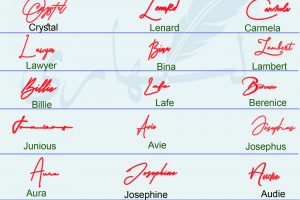Understanding Initial Signature: What It Is and How It Works
An initial signature is a type of signature that uses only the initials of a person’s name, rather than the full name. In this article, we will explore what an initial signature is, how it works, and its benefits compared to other signature options.
What is an Initial Signature?
An initial signature is a signature that uses only the initials of a person’s name. For example, instead of signing “John Smith,” a person would sign “J.S.” This type of signature is often used in situations where space is limited, such as on business cards or official documents.
How Does an Initial Signature Work?
To create an initial signature, a person needs to decide on the appropriate initials to use. Typically, the initials used are the first letter of the first name and the first letter of the last name. Once the initials have been decided upon, the person can practice writing them until they are comfortable and consistent.
When using an initial signature, it is important to ensure that it is recognizable as your signature. This can be achieved through practice and consistency in how the initials are written.
The Benefits of Using an Initial Signature
Using an initial signature offers several benefits over other signature options:
1. Space-saving: Initial signatures take up less space than full signatures, making them ideal for situations where space is limited.
2. Time-saving: Initial signatures are quicker to write than full signatures, which can save time when signing multiple documents.
3. Security: Initial signatures can be more secure than full signatures, as they are less likely to be easily imitated or forged.
4. Professionalism: Initial signatures can give a professional and efficient impression, particularly in formal settings.
When to Use an Initial Signature
Initial signatures are often used in formal or professional settings, such as on business cards, legal documents, or correspondence. They can also be used in situations where space is limited, such as on checks or credit card receipts.
It is important to note that not all situations are appropriate for an initial signature. For example, when signing personal letters or greeting cards, a full signature may be more appropriate.
Creating a Consistent Initial Signature
Creating a consistent initial signature requires practice and attention to detail. To create a consistent signature, a person should start by deciding on the appropriate initials to use. They should then practice writing those initials in a consistent manner, paying attention to the size, shape, and placement of the letters.
It can be helpful to create a template or guide for the signature, which can be used as a reference when signing documents.
Conclusion
An initial signature is a space-saving, time-saving, and secure way to sign documents. They can be particularly useful in formal or professional settings, or situations where space is limited. To create a consistent initial signature, a person should decide on the appropriate initials, practice writing them in a consistent manner, and pay attention to detail when signing documents. By following these steps, a person can create a professional and efficient signature that is unique to them.









Add Comment